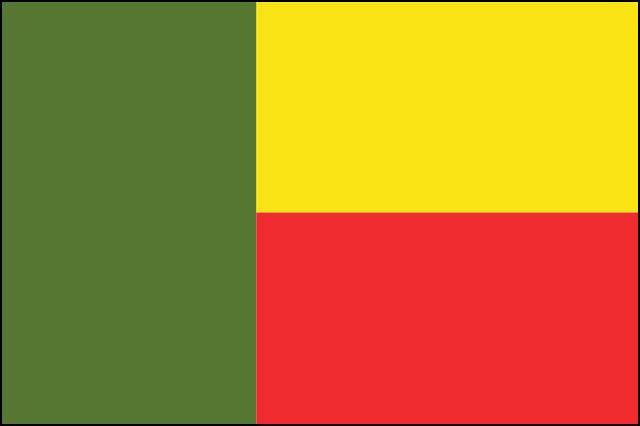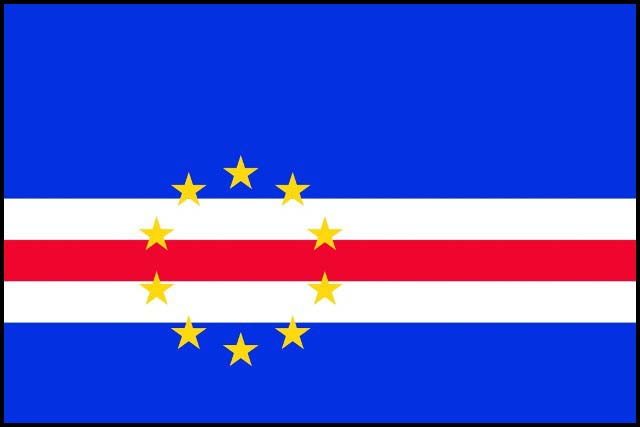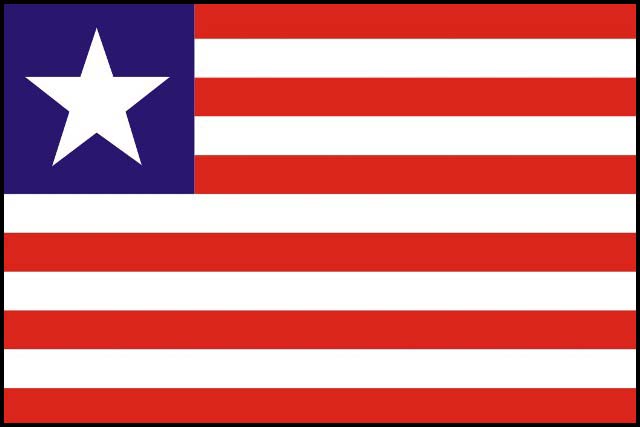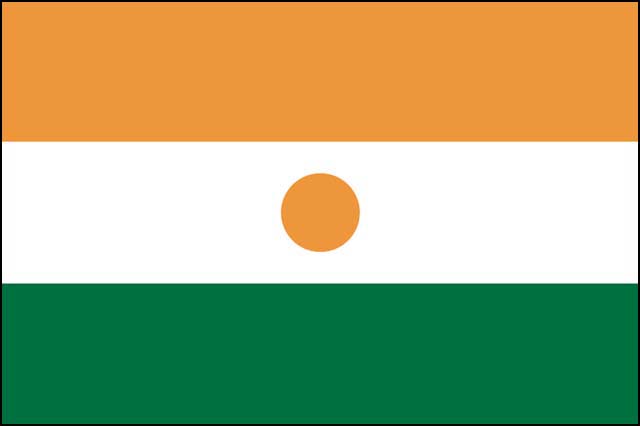Niger
Overview of the country
In long form, the Republic of Niger is a country in West Africa, located between Algeria to the north-northwest, Libya to the northeast, Chad to the east, Nigeria in the south, Benin in the south-southwest, Burkina Faso and Mali in the west-southwest. The capital is Niamey.
Niger's geographical location makes it a crossroads of exchanges between North Africa and Africa in the south of the Sahara. Located in West Africa between the parallels 11 ° 37 and 23 ° 33 north latitude on the one hand, and the meridians 16 ° east longitude and 0 ° 10 west longitude on the other hand, Niger extends over 1,267 000 km². It is the largest of the West African countries and ranks 6th on the continental scale (after Sudan, Algeria, Congo, Libya and Chad). Niger is part of the Economic Community of West African States (ECOWAS) and the Organization of Islamic Cooperation.
Surface water resources are relatively large and are divided into two main areas: the Niger River basin and the Lake Chad basin.
The Niger River basin comprises five (5) hydrological units which are the Niger River (crossing the country over 550 km) and its tributaries on the right bank (Gorouol, Dargol, Sirba, Goroubi, Diamangou, Tapoa, Mékrou); the tributaries of the left bank (fossil or dallol valleys); Ader - Doutchi - Maggia; the Goulbis (N'Maradi and N'Kaba) and the upper valley of the Tarka; the koris of the Aïr. As for the Lake Chad basin, it has two (2) units: the Komadougou Yobé and the Lake Chad basin; and then the Koramas. Surface water represents an average annual volume of 30 billion m3, of which only 1% is currently used mainly for agricultural development.
Groundwater is evaluated at 2.5 billion m3 for the renewed flow, of which only 20% is used mainly for the purpose of drinking water supply, and 2000 billion m3 for fossil water very slightly affected by the mining activities.
Niger is divided into 8 regions: Agadez, Dosso, Maradi, Tahoua, Tillabéry, Zinder, Diffa and Niamey (Municipality with special status or City).
Niger's population is almost 20 million. The different ethnic groups are the Hausa (53.5% of the population), established between Dallol Maouri and Zinder who live in the center and the east of the country with a cultural area that is widely spread in Nigeria; the Djermas and Sonrhaïs (19% of the population) who occupy the west of the country; they include the Wogos and the Kourteïs; the Tuaregs (10.6%), Toubous (0.5%) and Arabs (0.3%) in the north and north-east; the Kanouris (4.6%) and the Boudoumas in the far east and the Peulhs (10.4%) scattered throughout the territory.
Political, economic and social context of the country
- Political context
The Republic of Niger is a semi-presidential democratic republic. The President of the Republic is the Head of State and the Prime Minister is the Head of the Government. The political system allows political parties. Executive power is vested in the Government and the legislative power is held both by the Government and by the Nigerien National Assembly. The judiciary is independent of the other two powers.
The National Assembly of Niger is the unicameral parliament. The assembly has 171 seats, its members are elected for a five-year term. The country is divided into 8 constituencies which elect several deputies on a proportional basis for a total of 158 deputies. The minimum requirement for a party to have a deputy is 5%. Eight special constituencies are planned to represent national minorities and five constituencies are planned for Nigeriens living abroad: in each, the election is made by first past the post.
The Nigerien judiciary is composed of four high courts: (i) the court of appeal; (ii) the supreme court; (iii) the high court of justice and (iv) the state security court.
In 2019, the political situation is marked by the continuation of the work of the Independent National Electoral Commission (CENI), notably through the principle of drawing up a biometric electoral file for the organisation of free, credible and transparent general elections and the maintenance of dialogue with the political parties, which allowed the creation of non-affiliated in the charter of political parties to take into account the case of non-affiliated political formations which now enjoy the status of third group after the Majority and the Opposition. Likewise, the National Council for Political Dialogue (CNDP) held its conflict prevention and management sessions in a consensual manner around issues of national interest. However, the political opposition did not participate in all sessions.
- Economic context
Economic growth in Niger is 6.3% in 2019, slightly down compared to 2018 (6.5%). However, it still exceeds that of the Economic Community of West African States - ECOWAS (3.8%) and would approach the growth of the West African Economic and Monetary Union - WAEMU (6 , 4%). Economic activity would be sustained by the effects of the construction and service sectors entering into public and private investments (African Union Summit, Diori Hamani Airport, Kandadji Dam, etc.) and agricultural production. Inflation would stand at -2.5% in 2019, according to the National Institute of Statistics (INS), well below the community standard of 3%.
Niger’s economy remains very little diversified and is still in its early stage. Indeed, agro-sylvo-pastoral and fishing activities constitute the sources of income for the overwhelming majority of the populations.
The acceleration of the implementation of the development policy for manufacturing industries and agro-industry by the Government in connection with the advantages offered by the Investment Code would make it possible to revitalize the said sector, create decent jobs and reduce poverty.
Service activities such as trade, transport, ICT and public administration are in second place in the ranking of sources of income.
In terms of integration, foreign trade improved better in 2019 with an overall surplus of 317.7 billion against a deficit of 114.0 billion FCFA in 2018. This improvement in the overall balance of payments over the period is mainly explained by the good orientation of the capital and financial accounts following the increase in foreign direct investment.
- Social context
Niger's population was 17,138,707 in 2012 (RGP/H, 2012). It is estimated at nearly 20 million inhabitants in 2019. The intercensal population growth rate is one of the highest in the world, at 3.9% per year. The Nigerien population is extremely young and is predominantly rural. The rate of urbanization is low. The average population density is 13.5 inhabitants / km2 but the majority of Nigeriens live in the southern part of the country favorable to agro-pastoral activities.
Despite the demographic weight and the weakness of the economy, the efforts made in the social field have made it possible to record significant progress, particularly in the context of improving the population's access to basic social services.
In the education sector, access and quality indicators at all levels of education have generally improved. With regard to the primary education sub-sector, the indicator relating to the quality of primary education has shown an upward trend. Indeed, the primary completion rate (PCR) rose from 62.0% in 2018 to 65.4% in 2019. The same trend was observed for the PCR for girls, which rose from 57,2% in 2018 to 60.2% in 2019. For lower secondary education, the TBS goes from 36.8 in 2018 to 30.1% in 2019.
In the area of health, efforts focus in particular on strengthening of health infrastructures and the continuing efforts to deliver local services which made it possible to improve the rate of access to health care services from 50.6% in 2018 to 51.35% in 2019. In terms of food, the prevalence rate of malnutrition among children under 5 was 15% in 2018.
Niger has one of the lowest human development index in the world. In fact, it was 0.354 in 2017 in Niger and this value is significantly lower than the average for countries with a low HDI (0.504) and sub-Saharan Africa (0.537). The weakness of this index for Niger is all the more important when compared to the averages of countries with medium HDI (0.645), high (0.757), very high (0.894) and even the world average (0.728). Nonetheless, Niger’s HDI has seen a gradual, albeit slight, increase. It rose from 0.311 in 2005 to 0.313 in 2008; 0.324 in 2011; 0.353 in 2014 and 0.354 in 2017.
However, improvements remain weak in face of strong social demand and the challenges the country is facing in terms of mobilizing public revenue and controlling budgetary expenditure. It is within this framework that the Government maintained the principle of dialogue with the social partners, which has enabled the signing of a memorandum of understanding with the Nigerien Intersyndical (ITN).
Agro-sylvo-pastoral and fishery sector
The majority of the Nigerien population lives from the cultivation of local cereals (millet, sorghum). These two cereals alone contribute more than 60% of the diet of our population. The development of other irrigated cereals (maize, rice, wheat) is part of the orientations of the 3N Initiative. With a population growth rate of 3.9%, a sustained growth in cereal production is needed to achieve stable food security. The development of agricultural sectors and value chains is included in the priority orientations of the 2016-2020 programming phase.
This strategic program aims to:
- increase the production level of rainfed and irrigated crops through improved supply of inputs and equipment. This involves increasing the yields of the various sectors in order to raise cereal production from 5.5 million tonnes in 2015 to 8 million tonnes in 2020 and to increase production under irrigation from 500,000 tonnes of cereal equivalent. in 2015 to more than 1,500,000 tonnes of cereal equivalent in 2020.
- increase the storage capacities of both cereal and cash crops;
- intensify the processing of products to increase demand and stimulate production. To do this, it will be necessary to promote the creation of factories for the processing of agricultural products and to strengthen traditional units;
- facilitate the marketing of products: activities will be oriented towards facilitation through the creation and strengthening of markets, the creation of support and accompaniment structures (Agencies and counters, fairs, etc.), the provision of credits in support to commercialisation.
Additional information
With regard to rural development and food security, the implementation of the 3N Initiative strategy has made it possible to improve agro-sylvo-pastoral and fishery productions, to strengthen the integrated management of natural resources and increase the resilience of vulnerable groups. However, efforts to mobilize water and develop irrigated areas must continue in order to achieve the objectives of the Renaissance Program. Similarly, progress in terms of the recovery of degraded lands and in the vaccination coverage of the livestock falls below of the ambitions of the Renaissance Program.














